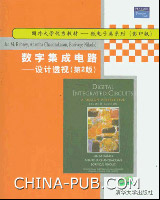 《數字積體電路》
《數字積體電路》【原出版社】PrenticeHall/Pearson
【作者】JanM.Rabaey,AnanthaChandrakasan,BorivojeNikolic[同作者作品]
【叢書名】國外大學優秀教材——微電子類系列(影印版)
【出版社】清華大學出版社
【書號】7302079684
【出版日期】2004年3月
【開本】16開
【頁碼】761
【版次】2-1
【所屬分類】工業技術>電工技術>電路>積體電路教材>研究生/本科/專科教材>工學>電工電子
本書的特點主要包括:(1)將數字積體電路設計中電路與系統的視角統一起來,在系統深入地介紹了深亞微米條件下半導體器件的知識和最基本的反相器後,作者逐漸將這些基礎知識引入到更加複雜的模組,比如門、暫存器、控制器、加法器、乘法器和存儲器等。在深亞微米的設計條件下,設計者不僅僅需要考慮整個系統的設計問題,還要隨時警惕在電路級——比如器件和連線所帶來的問題。(2)本書是第一本將數字積體電路設計問題集中在深亞微米條件下的參考書,並且提供了一個深亞微米條件下的簡電晶體模型。另外針對深亞微米條件下設計人員所面對的新挑戰,例如互連線問題、信號完整性問題、時鐘分布問題、功耗問題等,全書都做了非常詳細的論述。(3)書中的內容緊扣當今數字積體電路設計的核心問題,並通過大量的設計實例向讀者介紹了最新的設計技術和工程發展現狀與趨勢。
目錄
Chapterl:Introduction
1.1AHistoricalPerspective
1.2IssuesinDigitalIntegratedCircuitDesign
1.3ToProbeFurther
1.4Exercises
PART1:ACIRCUITPERSPECTIVE
Chapter2:TheDevices
2.1Introduction
2.2TheDiode
2.2.1AFirstGlanceattheDevice
2.2.2StaticBehavior
2.2.3Dynamic,orTransient,Behavior
2.2.4TheActualDiode-SecondaryEffects
2.2.5TheSPICEDiodeModel
2.3TheMOS(FET)Transistor
2.3.1AFirstGlanceattheDevice
2.3.2StaticBehavior
2.3.3DynamicBehavior
2.3.4TheActualMOSTransistor-SecondaryEffects
2.3.5SPICEModelsfortheMOSTransistor
2.4TheBipolarTransistor
2.4.1AFirstGlanceattheDevice
2.4.2StalicBehavior
2.4.3DynamicBehavior
2.4.4TheActualBipolarTransistor-SecondaryEffects
2.4.5SPICEModelsfortheBipolarTransistor
2.5AWordonProcessVariations
2.6Perspective:FutureDeviceDevelopments
2.7Summary
2.8ToProbeFurther
2.9ExercisesandDesignProblems
AppendlxA:LayoutDesignRules
AppendlxB:Small-SlgnalModels
Chapter3:TheInverter
3.1Introduction
3.2DelinitionsandProperties
3.2.1AreaandComplexity
3.2.2FunctionalityandRobustness:TheStaticBehavior
3.2.3Performance:TheDynamicBehavior
3.2.4PowerandEnergyConsumption
3.3TheStaticCMOSInvener
3.3.1AFirstGlance
3.3.2EvaluatingtheRobustnessoftheCMOSInverter:TheStaticBehavior
3.3.3PerfonnanceofCMOSInverter:TheDynamicBehavior
3.3.4PowerConsumptionandPower-DelayProduct
3.3.5ALookintotheFuture:EffectsofTechnologyScaling
3.4TheBipolarECLInverter
3.4.1IssuesinBipolarDigitalDesign:ACaseStudy
3.4.2TheEmitter-CoupledLogic(ECL)GateataGlance
3.4.3RobustnessandNoiseImmunity:TheSteady-StateCharacteristics
3.4.4ECLSwitchingSpeed:ThcTransientBehavior
3.4.5PowerConsumption
3.4.6LookingAhead:ScalingtheTechnology
3.5Perspective:Area,Perfonnance,andDissipation
3.6Summary
3.7ToProbeFurther
3.8ExercisesandDesignProblems
Chapter4:DesigningCombinationalLogkCatesinCMOS
4.1Introduction
4.2StaticCMOSDesign
4.2.1ComplementaryCMOS
4.2.2RatioedLogic
4.2.3Pass-TransistorLogic
4.3DynamicCMOSDesign
4.3.1DynamicLogic:BasicPrinciples
4.3.2PerfonnanceofDynamicLogic
4.3.3NoiseConsiderationsinDynamicDesign
4.3.4CascadingDynamicGates
4.4PowerConsumptioninCMOSGates
4.4.1SwitchingActivityofaLogicGate
4.4.2GlitchinginStaticCMOSCircuits
4.4.3Short-CircuitCurrentsinStaticCMOSCircuits
4.4.4AnalyzingPowerConsumptionUsingSPICE
4.4.5Low-PowerCMOSDesign
4.5Perspective:HowtoChooseaLogicStyle
4.6Summary
4.7ToProbeFurther
4.8ExercisesandDesignProblems
AppendixC:LayoutTechniquesforComplexCates
Chapter5:VeryHighPerfonnanceDigitalCircuits
5.1Introduction
5.2BipolarGateDesign
5.2.1LogicDesigninECL
5.2.2DifferentialECL
5.2.3CurrentModeLogic
5:2.4ECLwithActivePull-Downs
5.2.5AltemativeBipolarLogicStyles
5.3TheBiCMOSApproach
5.3.1TheBiCMOSGateataGlance
5.3.2TheStaticBehaviorandRobustnessIssues
5.3.3PerfonnanceoftheBiCMOSInverter
5.3.4PowerConsumption
5.3.5TechnologyScaling
5.3.6DesigningBiCMOSDigitalGates
5.4DigitalGalliumArsenideDesign*
5.4.1GaAsDevicesandTheirProperties
5.4.2GaAsDigitalCircuitDesign
5.5Low-TemperatureDigitalCircuits*
5.5.1Low-TemperatureSiliconDigitalCircuits
5.5.2SuperconductingLogicCircuits
5.6Perspective:WhentoUseHigh-PerformanceTechnologies
5.7Summary
5.8ToProbeFurther
5.9ExercisesandDesignProblems
AppendlxD:TheSchottky-BamerOiode
Chapter6:DesigningSequentialLogicCircuits
6.1Introduction
6.2StaticSequentialCircuits
6.2.1Bistability
6.2.2Flip-FlopClassification
6.2.3Master-SlaveandEdge-TriggeredFFs
6.2.4CMOSStaticFlip-Flops
6.2.5BipolarStaticFlip-Flops
6.3DynamicSequentia)Circuits
6.3.1ThePseudostaticLatch
6.3.2TheDynamicTwo-PhaseFlip-Flop
6.3.3TheC2MOSLatch
6.3.4NORA-CMOS-ALogicStyleforPipelinedStructures
6.3.5TrueSingle-PhaseClockedLogic(TSPCL)
6.4Non-BistableSequentialCircuits
6.4.1TheSchmittTrigger
6.4.2MonostableSequentialCircuits
6.4.3AstableCircuits
6.5Perspective:ChoosingaClockingStrategy
6.6Summary
6.7ToProbeFunher
6.8ExercisesandDesignProblems
PART11:ASYSTEMSPERSPECTIVE
Chapter7:DesigningArithmeticBuildingBlocks
7.1Introduction
7.2DatapathsinDigitalProcessorArchitectures
7.3TheAdder
7.3.1TheBinaryAdder:Definitions
7.3.2TheFullAdder:CircuitDesignConsiderations
7.3.3TheBinaryAdder:LogicDesignConsiderations
7.4TheMultiplier
7.4.1TheMultiplier:Definitions
7.4.2TheArrayMultiplier
7.4.3OtherMultiplierStructures
7.5TheShifter
7.5.1BarrelShifter
7.5.2LogarithmicShifter
7.6OtherArithmeticOperators
7.7PowerConsiderationsinDatapathStructures
7.7.1ReducingtheSupplyVoltage
7.7.2ReducingtheEffectiveCapacitance
7.8Perspective:De.signasaTrade-off
7.9Summary
7.10ToProbeFurther
7.11ExercisesandDesignProblems
AppendixE:FromDatapathSchematicstoLayout
Chapter8:CopingwlthInterconnect
8.1Introduction
8.2CapacitiveParasitics
8.2.1ModelingInterconnectCapacitance
8.2.2CapacitanceandReliability-CrossTalk
8.2.3CapacitanceandPerformanceinCMOS
8.2.4CapacitanceandPerformanceinBipolarDesign
8.3ResistiveParasitics
8.3.1ModelingandScalingofInterconnectResistance
8.3.2ResistanceandReliability-OhmicVoltageDrop
8.3.3Electromigration
8.3.4ResistanceandPerformance-RCDelay
8.4InductiveParasitics
8.4.1SourcesofParasiticInductances
8.4.2InductanceandReliability-VoltageDrop
8.4.3InductanceandPerformance-TransmissionLin5eEffects
8.5CommentsonPackagingTechnology
8.5.1PackageMaterials
8.5.2InterconnectLevels
8.5.3ThennalConsiderationsinPackaging
8.6Perspective:WhentoConsiderInterconnectParasitics
8.7ChapterSummary
8.8ToProbeFurther
8.9ExercisesandDesignProblems
Chapter9:TimingIssuesinDigitalCircuits
9.1Introduction
9.2ClockSkewandSequentialCircuitPerformance
9.2.1Single-PhaseEdge-TriggeredClocking
9.2.2Two-PhaseMaster-SlaveClocking
9.2.3OtherClockingStyles
9.2.4HowtoCounterClockSkewProblems
9.2.5CaseStudy-TheDigitalAlpha21164Microprocessor
9.3Self-TimedCircuitDesign*
9.3.1Selt-TimedConcept
9.3.2Completion-SignalGeneration
9.3.3Self-TimedSignaling
9.4SynchronizersandArbiters*
9.4.1Synchronizers-ConceptandImplementation
9.4.2Arbiters
9.5ClockGenerationandSynchronization*
9.5.1ClockGenerators
9.5.2SynchronizationattheSystemLevel
9.6Perspective:SynchronousversusAsynchronousDesign
9.7Summary
9.8ToProbeFurther
9.9Exerci.sesandDesignProblems
Chapter10:DesigningMemoryandArrayStructures
10.1Introduction
10.2SemiconductorMemories--AnIntroduction
10.2.1MemoryClassification
10.2.2MemoryArchitecturesandBuildingBlocks
10.3TheMemoryCore
10.3.1Read-OnlyMemories
10.3.2NonvolatileRead-WriteMemories
10.3.3Read-WriteMemories(RAM)
10.4MemoryPeripheralCircuitry
10.4.1TheAddressDecoders
10.4.2SenseAmplifiers
10.4.3Drivers/Buffers
10.4.4TimingandControl
10.5MemoryReliabilityandYield
10.5.1Signal-To-NoiseRatio
10.5.2Memoryyield
10.6CaseStudiesinMemoryDesign
10.6.1TheProgrammableLogicArray(PLA)
10.6.2A4MbitSRAM
10.7Perspective:SemiconductorMemoryTrendsandEvolutions
10.8Summary
10.9ToProbeFurther
10.10ExercisesandDesignProblems
Chapterll:DeslgnMethodologles
11.1Introduction
11.2DesignAnalysisandSimulation
11.2.1RepresentingDigitalDataasaContinuousEntity
11.2.2RepresentingDataasaDiscreteEntity
11.2.3UsingHigher-LevelDataModels
11.3DesignVerification
11.3.1ElectricalVerification
11.3.2TimingVerification
11.3.3Functional(orFonnal)Verification
11.4ImplementationApproaches
11.4.1CustomCircuitDesign
11.4.2Cell-BasedDesignMethodology
11.4.3Anay-BasedImplementationApproaches
11.5DesignSynthesis
11.5.1CircuitSynthesis
11.5.2LogicSynthesis
11.5.3ArchitectureSynthesis
11.6ValidationandTestingofManufacturedCircuits
11.6.1TestProcedure
11.6.2DesignforTestability
11.6.3Test-PattemGeneration
11.7PerspectiveandSummary
11.8ToProbeFurther
11.9ExercisesandDesignProblems
ProblemSolutions
【前言】
出版前言
微電子技術是信息科學技術的核心技術之一,微電子產業是當代高新技術產業群的核心和維護國家主權、保障國家安全的戰略性產業。我國在《信息產業“十五”計畫綱要》中明確提出:堅持自主發展,增強創新能力和核心競爭力,掌握以積體電路和軟體技術為重點的信息產業的核心技術,提高具有自主智慧財產權產品的比重。發展積體電路技術的關鍵之一是培養具有國際競爭力的專業人才。
微電子技術發展迅速,內容更新快,而我國微電子專業圖書數量少,且內容和體系不能反映科技發展的水平,不能滿足培養人才的需求,為此,我們系統挑選了一批國外經典教材和前沿著作,組織分批出版。圖書選擇的..
【序言】
從事數字積體電路設計的人對於JanM.Rabaey所著的DigitalIntegratedCircuits:ADesignPerspective(《數字積體電路——設計透視》)一書應該不陌生。該書第1版於1996年由PearsonEducation公司出版,1998年清華大學出版社出版了該書的英文影印版,並多次增印,成為國內積體電路設計人員以及相關專業學生手中經典的參考書。時隔7年後的2003年,JanM.Rabaey,AnanthaChandrakasan以及BorivojeNikolic三人終於合著出版了該書的第2版。
在這7年中,CMOS製造技術依然保持著快速的發展步伐,最小線寬已經進入100nm以內,電路變得越來越複雜,超深亞微米的製造工藝使得器件的行為變得更加複雜
